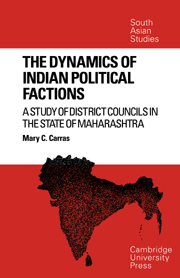Book contents
- Frontmatter
- Contents
- List of tables
- List of maps
- Acknowledgments
- 1 Introduction
- 2 The Argument
- 3 Political Integration: Empirical Conception and Method of Analysis
- 4 Ratnagiri District: Factional Alignments in Conditions of Poverty
- 5 Poona District: The Politics of Sugar
- 6 Aurangabad District: State versus District Leaders
- 7 Akola District: Factional Alignments in Conditions of Relative Plenty (The Politics of Cotton)
- 8 All Districts: Some Comparisons
- 9 Conclusion
- APPENDICES
- Notes
- Bibliography
- Index
8 - All Districts: Some Comparisons
Published online by Cambridge University Press: 23 November 2009
- Frontmatter
- Contents
- List of tables
- List of maps
- Acknowledgments
- 1 Introduction
- 2 The Argument
- 3 Political Integration: Empirical Conception and Method of Analysis
- 4 Ratnagiri District: Factional Alignments in Conditions of Poverty
- 5 Poona District: The Politics of Sugar
- 6 Aurangabad District: State versus District Leaders
- 7 Akola District: Factional Alignments in Conditions of Relative Plenty (The Politics of Cotton)
- 8 All Districts: Some Comparisons
- 9 Conclusion
- APPENDICES
- Notes
- Bibliography
- Index
Summary
The general hypothesis regarding the economic nature of factional groups was tested once again on members of each faction which, in the final analysis to be discussed here, included all the Rebels and all the Loyalists from the four districts, pooled together in their respective groups. In this chapter, we will be examining the characteristics of these rival groups as derived from this last series of discriminant analyses. Perhaps I ought to preface this discussion with a general observation (made earlier in Chapter 3) regarding the effectiveness of the variable clusters used as tests of discrimination and prediction of factional alignments. I would remind the reader that these tests do not compare well, on the whole, with equivalent tests applied separately in each district, specifically in regard to discriminating strength and predictive scope. With this caveat in mind, we may proceed to the interpretation of the findings yielded by this analysis.
As in the individual districts, so too on the all-district level, the cluster of combined variables proved to be the most powerful discriminator of Rebels and Loyalists. The strongest single predictor within this cluster was an indicator of the average size of land-holding owned by cultivators in the respective talukas of respondents (Table 1.1). It should be noted that the variable which thus proved most effective in identifying factional membership was an environmental one, with an economic connotation, and not one directly descriptive of the individual respondent.
- Type
- Chapter
- Information
- The Dynamics of Indian Political FactionsA Study of District Councils in the State of Maharashtra, pp. 161 - 183Publisher: Cambridge University PressPrint publication year: 1972



